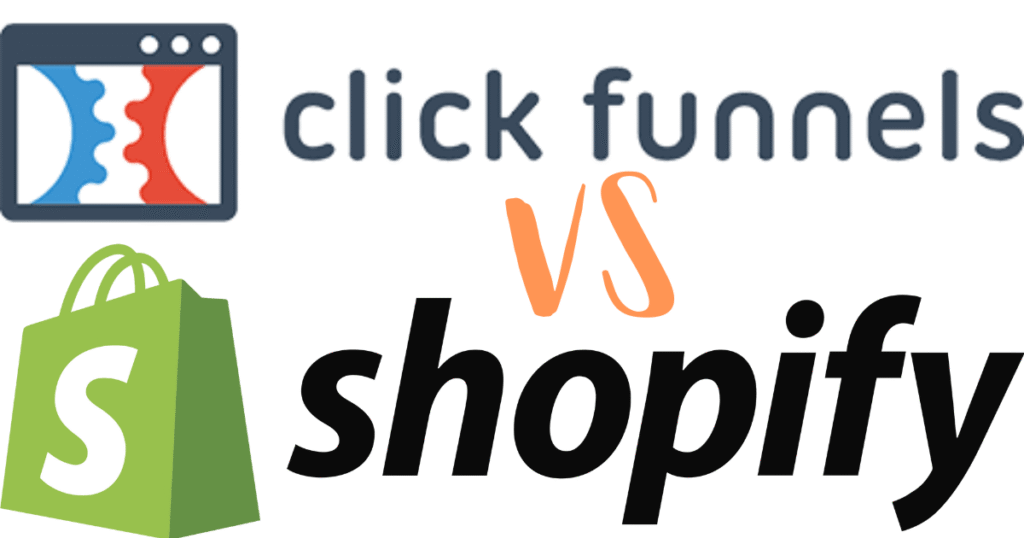This post contains affiliate links. If you purchase through these links, I may earn commission at no extra cost to you.
Wondering if ClickFunnels or Shopify is the right choice for your online business? In this ClickFunnels vs Shopify comparison, I’ll break down their key differences in features, pricing, and ideal use cases to help you decide which platform fits your needs best.
ClickFunnels vs Shopify are two very different tools – think of it like a personal sales funnel vs a full online storefront.
Table of Contents
Introduction
If you’re comparing ClickFunnels vs Shopify, you’re likely trying to figure out which platform will help you sell more effectively online. As someone who has used both, I can tell you they serve very different purposes – it’s almost like comparing apples to oranges. In fact, I often use a simple analogy: Shopify is like setting up your own retail store, while ClickFunnels is like hiring a personal salesperson who guides each customer through a custom sales pitch. Both approaches can work wonders, but they cater to different business models.
In this post, I’ll share what I’ve learned about Shopify and ClickFunnels, including their pros, cons, and real-world examples. We’ll talk about ease of use, design flexibility, e-commerce features, marketing tools, and pricing. My goal is to give you a clear, friendly breakdown so you can confidently choose the right tool for your needs. Let’s dive in!
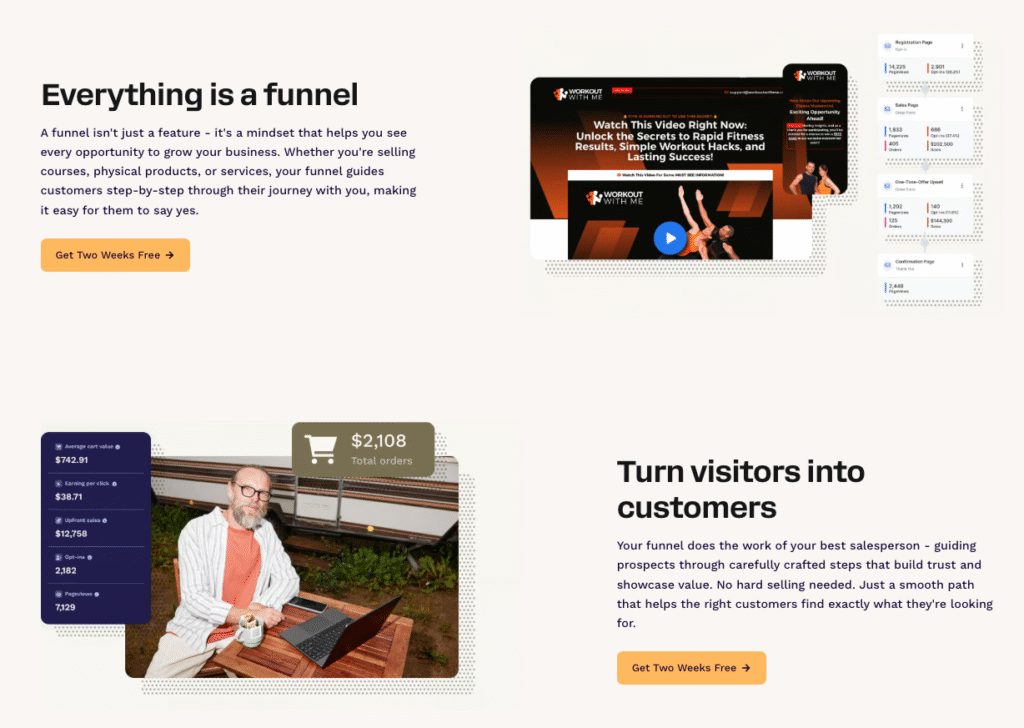
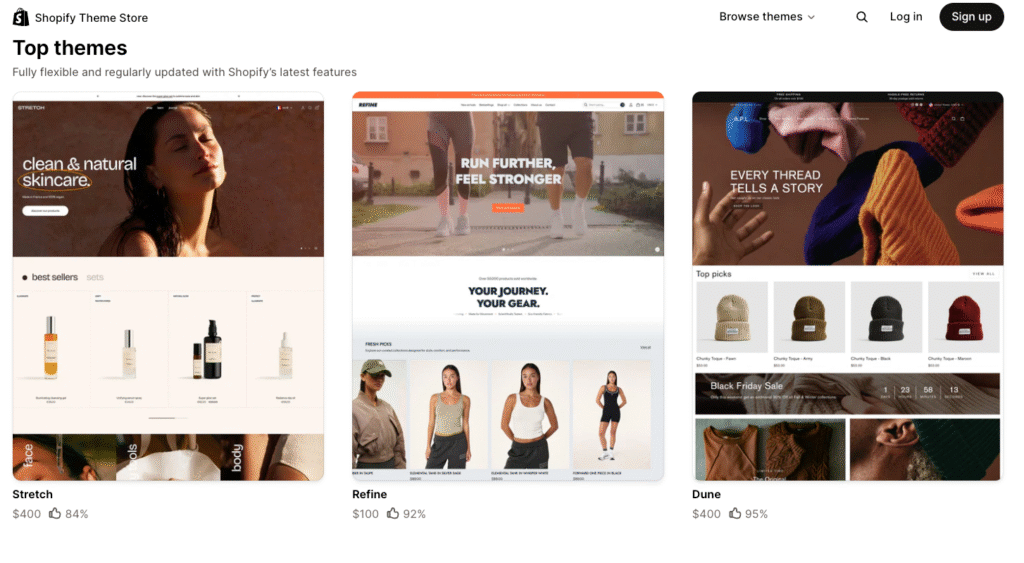
What is ClickFunnels?
ClickFunnels is an all-in-one online marketing platform focused primarily on building sales funnels – streamlined sequences of pages designed to convert visitors into leads and customers. It was founded in 2014 by entrepreneur Russell Brunson and has grown to over 110,000 users worldwide. The idea behind ClickFunnels is to give you the tools to create landing pages, sales pages, checkout forms, and even membership areas, all without needing to code.
In my experience, using ClickFunnels feels like having a dedicated sales team taking each customer by the hand. For example, if I’m selling an online course or a single product, I can set up a funnel that might start with an opt-in page (to capture email leads), then lead to a sales page, then a checkout page with an order bump (an easy one-click add-on offer), followed by an upsell or downsell page. This guided journey can significantly boost conversion rates and the average order value – some ClickFunnels users report their order bumps and upsells increase AOV by 10-30%.
Key features of ClickFunnels include a drag-and-drop funnel builder, dozens of pre-designed funnel templates (for webinars, product launches, lead magnets, etc.), built-in A/B testing tools, email marketing automation (through its Follow-Up Funnels feature on higher plans), and even affiliate management (so you can run an affiliate program for your products). The platform has expanded with ClickFunnels 2.0 to add more capabilities – like a basic website builder, CRM functionalities, and the ability to host courses or communities. However, its core strength remains funnel-based selling.
To put it simply, ClickFunnels is a specialist. It’s fantastic if you need to maximize conversions on a focused offer or marketing campaign. I find it especially useful for digital products, online courses, coaching services, or a small number of flagship physical products. It’s less ideal if you want to build a large, traditional e-commerce store with dozens of product categories – that’s where Shopify comes in.
“Try ClickFunnels with a free 14-day trial Affiliate Link”
What is Shopify?
Shopify, on the other hand, is a leading e-commerce platform designed for building full-featured online stores. Launched in 2006, Shopify powers millions of merchants in 175 countries and has facilitated over $1 trillion in sales to date. It’s essentially the Amazon of DIY online stores – a one-stop solution that provides everything you need to start selling physical or digital products through your own website.
When I use Shopify, it feels like I’m setting up a new brick-and-mortar shop, but on the internet. Shopify provides a store builder with a variety of templates/themes (over 250 themes available, 13 of which are free). You can list unlimited products, organize them into collections (categories), manage inventory and shipping, and process payments – all from an intuitive dashboard. Out of the box, Shopify gives you a shopping cart, secure checkout, and even a built-in blog for content marketing. Plus, there’s an app store with thousands of plugins (Shopify has over 8,000 apps for extending functionality, from SEO boosters to dropshipping integrations). In short, Shopify is a generalist – it’s built to handle everything about running an online retail business.
One thing I appreciate about Shopify is how easy it is for beginners. You don’t need to be tech-savvy to get a basic store up and running. For example, I was able to help a friend set up a Shopify store for her handmade crafts in a single afternoon – we chose a free theme, uploaded product photos, set prices, and we were live. Shopify also scales well: it can support small startups all the way to major brands (it even offers an enterprise plan, Shopify Plus, for very high-volume stores). Features like integrated payment processing (Shopify Payments), multi-currency support, and a robust inventory system make it ideal if you plan to grow a large catalog of products or sell globally.
In summary, Shopify is an e-commerce powerhouse. It’s the better choice if you need a full online storefront with shopping cart and product management, or if you plan to offer many different products (like running a clothing store, electronics shop, dropshipping business, etc.). However, it doesn’t inherently guide customers through a focused sales sequence the way ClickFunnels does – that’s a trade-off we’ll explore more below.
“Try Shopify free for 3 days (or get 3 months for $1) Affiliate Link”
ClickFunnels vs Shopify: Key Differences at a Glance
Both ClickFunnels and Shopify let you sell products online, but they approach it from completely different angles. The main difference comes down to sales funnels vs online stores. Let’s highlight a few core distinctions:
- Selling approach: ClickFunnels is laser-focused on guiding customers through a single sales funnel (great for one product or offer at a time with upsells/downsells), whereas Shopify provides a broad storefront for customers to browse multiple products in a catalog.
- Ease of setup: Shopify makes it easy to launch a standard online store with minimal technical know-how – you fill in product details and pick a theme. ClickFunnels also offers an easy page builder, but constructing an effective funnel can require more strategic thinking about the customer journey (I often find it takes a bit more planning or “mental load” than populating a simple store template).
- Design and templates: Shopify offers a huge selection of themes (around 250) for your store, giving a lot of design flexibility and professional look-and-feel. ClickFunnels has far fewer themes (around 8 for full sites/store funnels), instead providing many funnel page templates optimized for conversion. In general, Shopify’s themes look more polished for branding, while ClickFunnels’ templates are more about direct-response marketing (sometimes at the expense of subtlety).
- E-commerce features: Shopify is a complete e-commerce solution – it handles product management, inventory tracking, shipping calculations, taxes, multiple product variants, discount codes, etc., right out of the box. ClickFunnels has added some basic store features in 2.0 (you can sell products and track inventory in a limited way), but it’s best suited for simpler product setups (it’s great for digital products or small product lines, but managing hundreds of SKUs or complex inventory is where Shopify shines).
- Marketing tools: ClickFunnels includes built-in marketing tools geared toward maximizing conversions – think email marketing, upsells, downsells, one-click order bumps, affiliate program management, and webinar hosting. Shopify focuses on providing a solid store foundation and relies on apps for advanced marketing features. For example, Shopify has an abandoned cart recovery and basic email out of the box, but for elaborate funnels (upsell flows, countdown timers, etc.) you’d install apps or use Shopify + a funnel app. In essence, ClickFunnels gives you a lot of these funnel marketing tools by default, whereas Shopify gives you a stable platform you can extend as needed.
- Integrations and ecosystem: Shopify has a vast ecosystem – its App Store offers plugins for just about any feature you can imagine, from SEO to dropshipping suppliers. This means if Shopify lacks something, you can likely add it with an app (though often for an extra fee). ClickFunnels does integrate with many third-party services (email providers, payment gateways, etc.), but it doesn’t have an open app marketplace like Shopify’s. It’s more self-contained. If you need a specific integration beyond what ClickFunnels supports, you might use Zapier or custom code.
- SEO and blogging: If organic traffic and content marketing are part of your strategy, Shopify has the edge. Shopify includes a built-in blogging platform and lets you optimize SEO settings (URLs, meta tags, sitemaps, etc.) pretty extensively. Shopify stores also tend to have clean URL structures and faster load times for product pages, which is good for Google. ClickFunnels, by contrast, is not built for SEO – funnel pages can be SEO-optimized to a degree (you can set titles and meta descriptions), but there’s no native blog section and the pages often don’t rank well on search engines. Most people using ClickFunnels rely on paid ads or email campaigns to drive traffic, rather than expecting to get a lot of free Google traffic to a funnel page.
- Pricing: We’ll dive deeper into pricing later, but in short, Shopify’s entry cost is much lower. Shopify has plans starting at $39/month (Basic) and even a very limited Starter plan at $5, whereas ClickFunnels starts at $97/month for its basic plan. However, cost can even out when you consider Shopify apps (which can add monthly fees) and transaction fees, whereas ClickFunnels’ higher cost includes many marketing features built-in. We’ll compare this more in the pricing section.
Those are the quick highlights. Now, let’s examine some of these aspects in more detail, so you can better understand how each platform might fit your specific situation.
Ease of Use
Shopify – user-friendly store setup: In my experience, Shopify is very straightforward for beginners. The interface is clean and geared toward guiding you through store setup step by step. When you start a Shopify store, there’s a checklist that walks you through adding your products, setting up shipping, choosing a theme design, etc. It feels a bit like using a website builder tailored for e-commerce – no coding required. For most basic tasks (like updating a product price or fulfilling an order), Shopify’s admin is intuitive. The learning curve is mild, and there’s extensive documentation and 24/7 support if you get stuck. I’ve seen teens and non-techie folks create decent stores on Shopify in days, if not hours.
ClickFunnels – easy builder, but strategic thinking needed: ClickFunnels is also fairly easy technically. It has a drag-and-drop editor for pages, so designing the look of a funnel page is not hard. You start by picking a funnel template (e.g. a “Product Launch” funnel or a “Webinar Signup” funnel) and then you can customize each step. On a superficial level, I found it straightforward to swap in my images and text. However, the concept of building a sales funnel might be new to some users – it definitely was to me at first. You’re not just filling out product info; you’re crafting a marketing flow. This means you need to plan what pages you need and how customers move through them. For example, figuring out an effective upsell offer or writing persuasive landing page copy can be a bit of a challenge if you’re not used to sales funnels. In other words, ClickFunnels is technically easy to use, but you’ll spend more time thinking like a marketer than you might with Shopify. This isn’t a bad thing – it’s actually the whole point of ClickFunnels – but it’s a different mindset from the “list a product and sell it” approach of Shopify.
One thing to note: Shopify’s approach can sometimes feel limiting if you want to do something unconventional with the sales process (like a multi-step custom checkout – Shopify’s checkout is mostly fixed unless you use Shopify Plus). ClickFunnels gives you more flexibility to tweak the flow, but that comes with more responsibility to design it well. Overall, if you’re completely new to online selling, Shopify might feel less overwhelming to start with, whereas ClickFunnels might require a bit more marketing savvy to fully leverage.
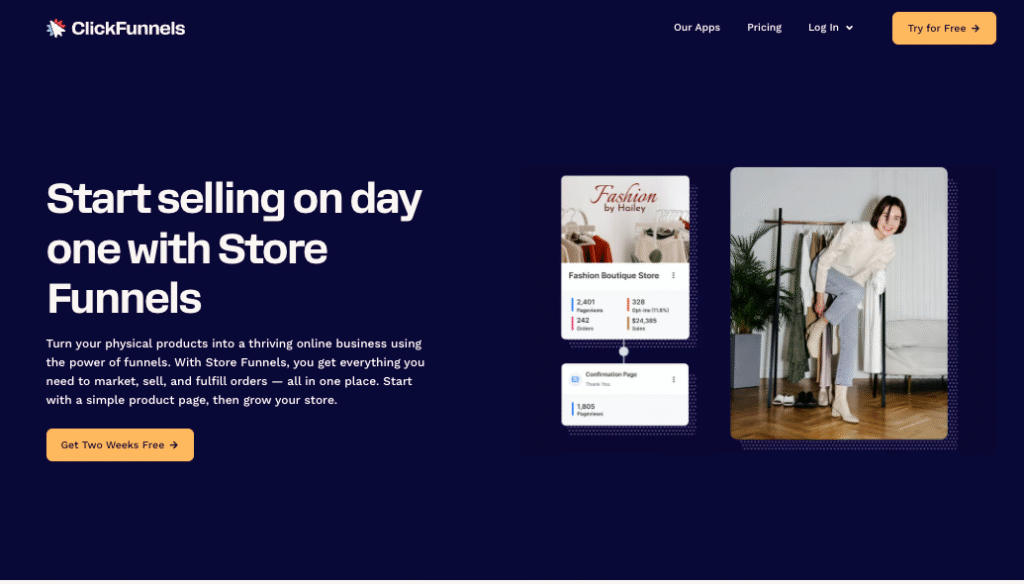
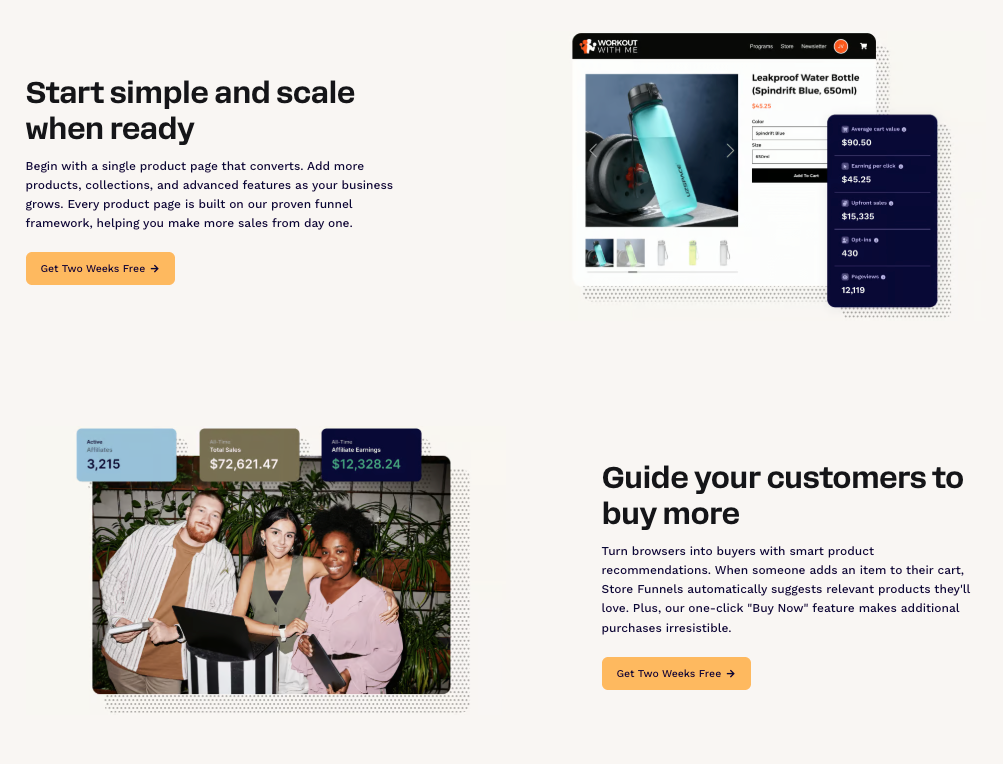
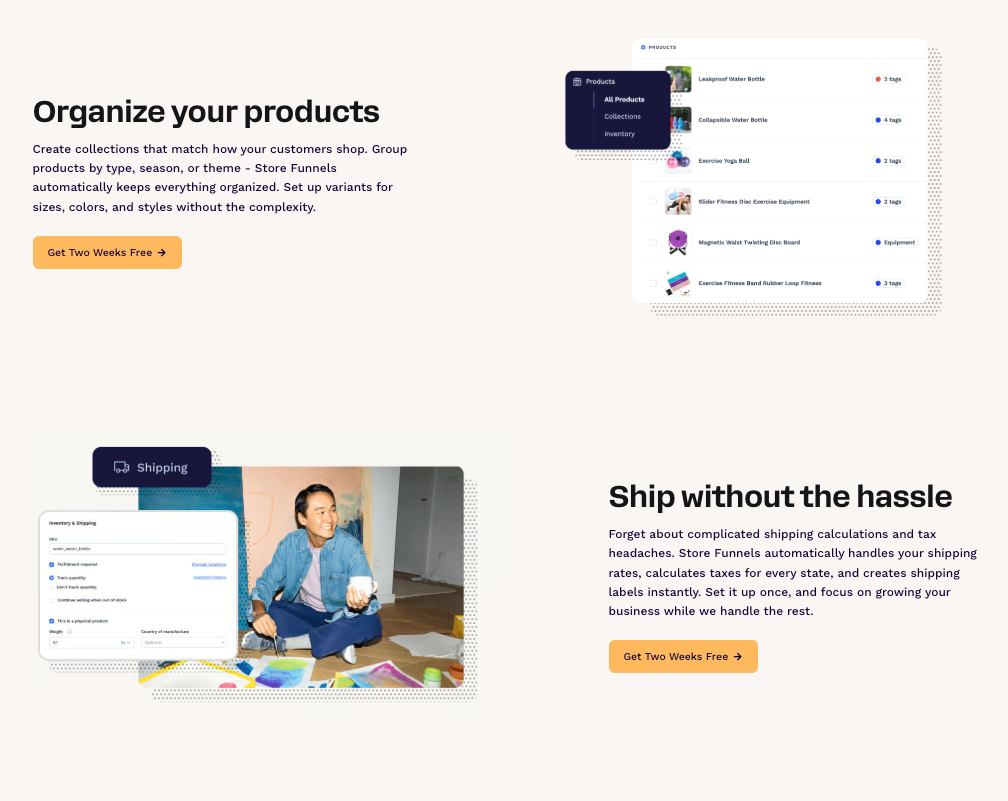
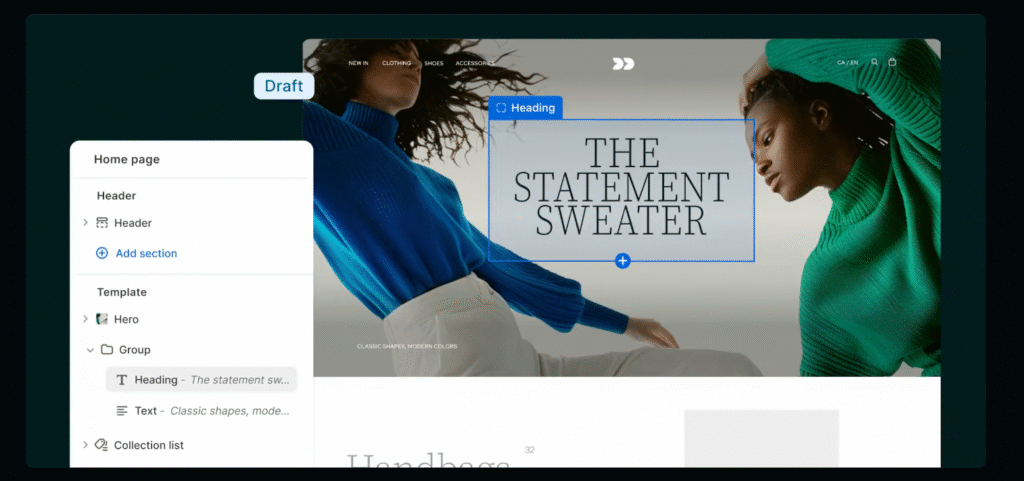
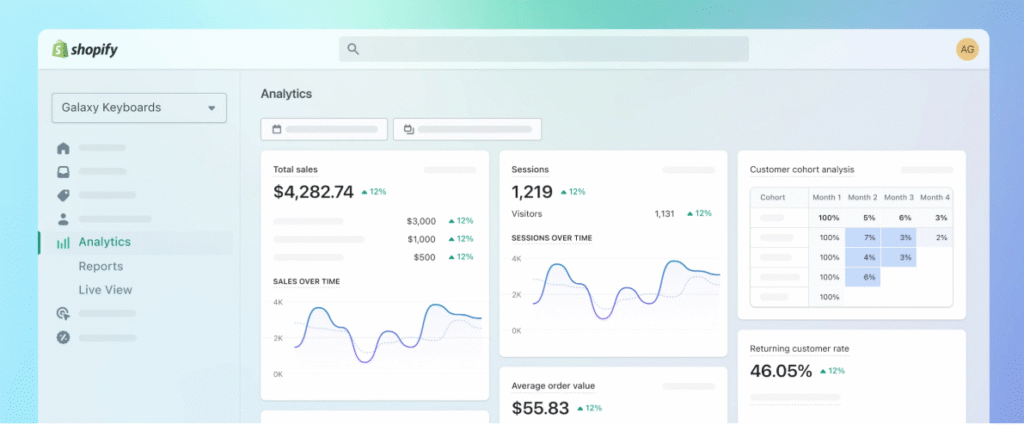
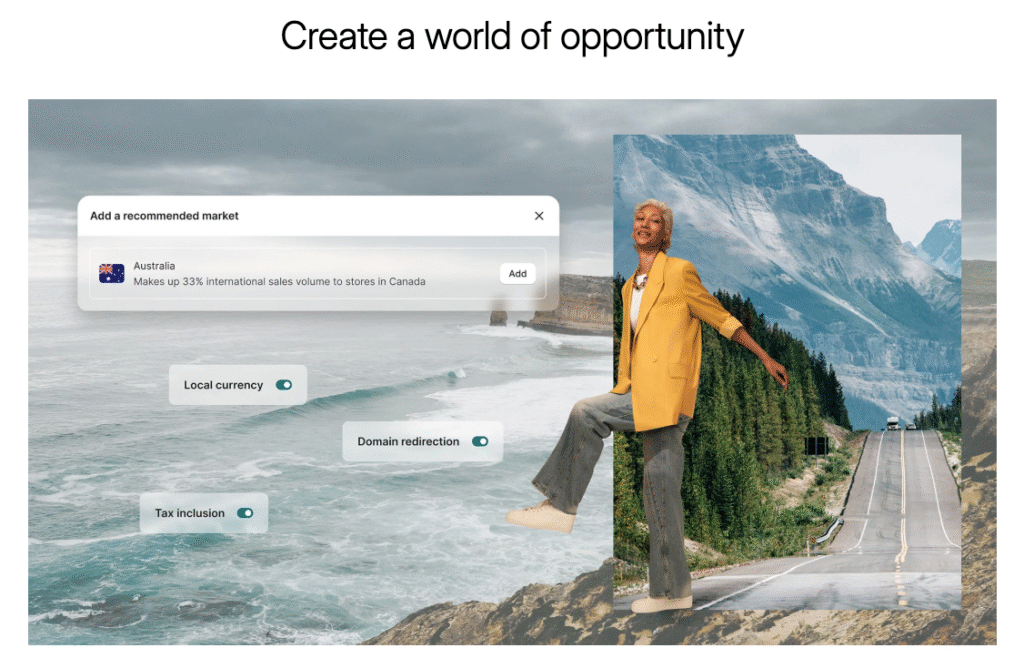
Design and Templates
Design can have a big impact on how professional your site looks and how well it converts visitors. Here’s how Shopify and ClickFunnels compare:
- Shopify’s themes: Shopify offers a wide selection of beautifully designed themes on its Theme Store – roughly 250 themes (free and paid combined) are available. These themes are created by professional designers and are generally optimized for different industries (fashion, electronics, food, etc.). I love that Shopify themes are mobile-responsive and highly customizable through the theme editor. You can change colors, fonts, layout sections, and more without touching code. If you do know a bit of code (or hire a developer), Shopify also allows deeper customization via HTML/CSS and Liquid (its templating language), so the sky’s the limit. In short, with Shopify, you can achieve a unique branded look fairly easily. The themes tend to be very polished – Shopify stores often have a modern, credible appearance, which is important for gaining customer trust.
- ClickFunnels’ templates: ClickFunnels comes from a marketing-first angle, so its design templates are more about conversion than aesthetics. ClickFunnels has a relatively small set of page templates and funnel themes – at last count, about 8 overall site themes and 14+ funnel page templates for different purposes. These are definitely editable (you can change colors, add sections, etc.), but the style out of the box can feel a bit “infomercial-y” or overly salesy to me. They often feature big bold headlines, timers, and bright call-to-action buttons – which actually work well for grabbing attention! But if you’re looking for a subtle, elegant brand vibe, ClickFunnels’ default look might not hit the mark. That said, because you can drag-and-drop elements, you can build a nice design in ClickFunnels – it just takes more manual effort and design sense, since you’re often starting from a very basic template. Also, you won’t have features like mega-menus or advanced product filtering on ClickFunnels pages – those are things Shopify themes excel at for browsing a large store.
To give a personal example: when I built a funnel for an e-book in ClickFunnels, I used a template that had a very strong sales letter style (testimonials, bold claims at top, etc.). It converted well, but I wouldn’t use that style if I were, say, building a full brand website for a high-end jewelry store – that’s where I’d prefer Shopify’s design flexibility and theme selection. In fact, Shopify’s templates often outshine ClickFunnels’ in pure visual appeal, but ClickFunnels’ simpler templates can sometimes perform better for focused campaigns (by removing distractions). It’s a trade-off between beauty and conversion intent.
In summary, if having a gorgeous storefront and lots of design options is a priority, Shopify is the winner. If you’re okay with a more utilitarian design that is laser-focused on driving a particular action (like signing up for a webinar or buying a single product), ClickFunnels provides what you need and you won’t get lost in endless design tweaks.
Sales and Marketing Features
This is where the two platforms really diverge. ClickFunnels was built for marketing, while Shopify was built for retail e-commerce – so each has strengths in different areas.
Sales Funnels and Conversion Tools (ClickFunnels’ strength): ClickFunnels includes all the classic funnel-enhancing features by default. For example, you can easily add:
- Upsells & Downsells: After a customer buys something (or even just before they finish checkout), you can show a one-click upsell offer. I use this to great effect – e.g., someone buys a $20 product, then I offer a premium version or related item for $40 on the next page with a single click. ClickFunnels makes this flow seamless, and it’s proven to increase total sales. Shopify, on its own, does not have one-click post-purchase upsells (you’d need an app for that, and even then, it’s tricky to integrate into the checkout without Shopify Plus). So ClickFunnels gives an edge here for maximizing each customer’s value.
- Order Bumps: This is like an add-on offer right on the checkout page (think of it as the candy bar at the grocery checkout). ClickFunnels lets you put a little checkbox offer during checkout like “Add this extra bonus for $9.” It’s very effective and easy to set up in ClickFunnels. On Shopify, again, you’d need an app or some custom coding to mimic this behavior.
- A/B Testing: On ClickFunnels, you can split test your pages natively – create two versions of a page and the system will send some traffic to each to see which converts better. This kind of built-in optimization tool is a marketer’s dream to fine-tune funnel performance. Shopify doesn’t have built-in A/B testing for pages (you might use Google Optimize or an app, but it’s not as straightforward for landing pages).
- Email marketing and follow-ups: ClickFunnels has its own email autoresponder system (Follow-Up Funnels) if you subscribe to a higher plan, which means you can capture emails and set up automated sequences (like nurture emails or cart abandonment emails) right within the platform. Shopify provides basic email sending (like an abandoned cart email and some email templates) and now has Shopify Email for simple campaigns, but if you want sophisticated email automation, you’ll likely integrate a dedicated email service (e.g., Klaviyo, MailChimp) with Shopify. With ClickFunnels, the idea is you might not need a separate email tool for simple funnels – it’s all in one.
- Affiliate program management: This is one area that’s really unique – ClickFunnels (on its Platinum plan or older Backpack feature) lets you run an affiliate program. That means you can have people sign up to promote your products and track their referral sales/commissions all inside ClickFunnels. Shopify has no native affiliate management; you’d have to get an app for that if you want affiliates. So if you plan on having a lot of affiliate marketers, ClickFunnels might appeal to you.
- Webinars and courses: ClickFunnels also supports things like webinar funnels (it can integrate with webinar hosting or even do simple ones itself) and membership areas to deliver online courses or gated content. Shopify is more transactional – it doesn’t natively support online course delivery (you’d use apps or a separate platform for that).
E-commerce and Store Features (Shopify’s strength): While ClickFunnels is winning at direct marketing tools, Shopify excels in traditional e-commerce capabilities:
- Product Management: Shopify is built to handle lots of products and complex product options. For example, in my Shopify store I can have a product with multiple variants (size, color, etc.) and track inventory for each variant. Shopify has a robust inventory tracking system, SKU management, and even alerts for low stock. ClickFunnels recently added product variants in CF 2.0, but it’s still not as sophisticated. If you have an extensive catalog or need things like SKU codes, barcodes, or integration with POS (point of sale) for retail, Shopify is the clear choice. In fact, Shopify can manage millions of products and large inventories with ease, whereas ClickFunnels is ideal for a handful of products – beyond that it gets unwieldy.
- Shopping Cart & Checkout: Shopify’s checkout is optimized for general use – it supports discount codes, gift cards, multiple shipping options, tax calculations, and letting customers buy multiple different items at once. ClickFunnels’ checkout is designed for a funnel (usually one product at a time, possibly with add-ons). If you want customers to be able to browse your site, add 3-4 different items to a cart, then check out with all of them together, Shopify is built exactly for that. ClickFunnels doesn’t really have a multi-item cart in the same way; it’s usually one core offer at a time (though you can bundle things in one offer). Also, Shopify’s checkout can be translated to multiple languages and handle various tax scenarios automatically – super important if you sell internationally or need things like VAT taxes handled.
- Payment Options: Shopify integrates with over 100 payment gateways worldwide. Plus it has its own Shopify Payments solution (which if used, means no extra transaction fees and it seamlessly accepts credit cards, Apple Pay, etc.). With Shopify, you can offer multiple payment methods (credit card, PayPal, Shopify Pay, Amazon Pay, even cryptocurrency in some cases via apps) all at once. ClickFunnels integrates primarily with Stripe, PayPal, and a few others, but notably you can only use one payment gateway per funnel. So, for example, you can’t easily offer PayPal and credit card option on the same ClickFunnels checkout without some custom workaround – you’d often need to send to a separate PayPal order page. That can be a drawback if your customers expect choices at checkout. Also, Shopify automatically handles payment security, PCI compliance, fraud analysis on orders, etc., which is very reassuring when running a store.
- Shipping & Fulfillment: For anyone shipping physical products, Shopify has a ton of features to simplify this. You can set shipping rates by weight or location, offer realtime carrier rates on higher plans, print shipping labels, integrate with fulfillment centers or dropshipping suppliers (apps like Oberlo, etc.), and even manage in-store pickup if you have a physical shop. Shopify’s back-end is like a full inventory and order management system – you can see orders, mark them fulfilled, send tracking to customers, all in one place. ClickFunnels can sell physical products and even has basic shipping settings for products (like weight and order quantity limits), but it lacks the depth of shipping integrations. Typically, people using ClickFunnels for physical products will integrate with Shopify or another system for the actual fulfillment process, or they handle it manually for small scale. If you plan on doing serious order volume with physical goods, Shopify’s tools are a lifesaver. As one blogger put it, Shopify excels in shipping and fulfillment management, offering automatic shipping rates and easy order processing, whereas ClickFunnels requires more manual work or add-ons for these tasks.
- Point of Sale (POS): This might be tangential, but worth noting: if you ever want to sell in person (like at a craft fair or retail store), Shopify has POS systems that sync with your online inventory. ClickFunnels has nothing for brick-and-mortar sales.
Marketing & SEO: We touched on marketing differences, but a bit more:
- Built-in SEO & Content Marketing: Shopify, as mentioned, has the basics for SEO – customizable meta titles, alt text for images, SEO-friendly themes, automatic sitemaps, etc. It also supports blogging so you can drive organic traffic with content. ClickFunnels is not great for content-heavy sites or SEO-driven traffic. Many entrepreneurs using ClickFunnels will actually run a blog on a separate platform (like WordPress or Shopify or Webflow) to get organic traffic, then link into a ClickFunnels funnel for conversion. That’s a perfectly viable combo approach, but it means ClickFunnels alone isn’t your solution if SEO is a big part of your strategy.
- Ads and analytics: Both platforms can work with your Facebook Pixel, Google Analytics, etc., but ClickFunnels is almost always used in conjunction with paid ads on Facebook/Google/YouTube. Shopify stores do a mix of ads and organic. One thing: Shopify has more advanced analytics for e-commerce (sales by product, customer lifetime value, etc., especially on higher plans), whereas ClickFunnels gives you stats funnel-by-funnel (opt-in rates, sales per funnel) but not as much overall business reporting. Depending on what you need, this could be a factor.
To sum up this section: ClickFunnels arms you with powerful selling tools to squeeze the most revenue out of each visitor, making it ideal for marketing campaigns or single product focus. Shopify arms you with robust store management tools to build a long-term online store, making it ideal for running a broad e-commerce business. A lot of businesses actually use both in tandem – for example, a Shopify store for the main catalog and website, and ClickFunnels for specific product launches or marketing funnels driving into that store. We’ll talk more about using them together later on.
Pricing Comparison
Cost is always an important consideration, especially for entrepreneurs just starting out. Here’s a breakdown of how Shopify and ClickFunnels pricing stack up (note: pricing is as of 2025 and could change):
Shopify Pricing: Shopify offers several plans suited for different stages of business:
- Starter Plan – $5/month: This super-cheap plan isn’t a full store; it’s meant for selling on social media or adding buy buttons to an existing site. It’s very limited (no standalone storefront), but it’s an option if you just want basic buy links.
- Basic Shopify – $39/month: This is the entry-level full store plan. It gives you a fully functional online store with 2 staff accounts, basic reports, and up to 4 inventory locations. This plan now includes features like discount codes and abandoned cart recovery. For many new businesses, Basic is sufficient to start.
- Shopify (Standard) – $105/month: Sometimes called the “Grow” plan (recently renamed from just “Shopify”), it allows up to 5 staff accounts, professional reports, and better shipping discounts. It’s for a growing business that needs more features and a slightly lower credit card rate.
- Advanced Shopify – $399/month: This is for scaling businesses. It offers up to 15 staff, even deeper shipping discounts, advanced report builder, and the lowest transaction fees. Also adds features like third-party calculated shipping rates at checkout.
- Shopify Plus – starting around $2,000+/month: This is enterprise level. It’s for high-volume merchants and comes with dedicated support, the ability to fully customize checkout, and many more perks.
Shopify also often has an offer where you can pay $1/month for the first 3 months on a new store (as a trial promo), or you can get around 25% off by paying annually. For instance, the $39 Basic becomes roughly $29/month on an annual plan. Transaction fees: If you use Shopify Payments, you just pay the credit card processing (around 2.9% + 30¢ on Basic, and lower on higher plans). If you use an external gateway like PayPal, Shopify will take an additional 2.0% fee on Basic (this drops to 1% on Standard, 0.5% on Advanced). So it encourages you to use their built-in system, which works well in supported countries.
ClickFunnels Pricing: ClickFunnels’ pricing has changed a bit with the 2.0 rollout, but as of now it essentially has two main plans (monthly):
- ClickFunnels (Basic) – $97/month: This is often referred to as the “Startup” plan. It includes the core funnel builder and lets you create up to 20 funnels, 100 pages, and have 1 user account. It’s fairly feature-rich for a single user focusing on funnels. However, some advanced features (like follow-up email tools or affiliate program) are not in this plan.
- ClickFunnels (Platinum / Pro) – $297/month: This higher plan gives you unlimited funnels and pages, up to 3 users, and unlocks the full suite including Follow-Up Funnels (email automation) and Backpack (affiliate management system). It’s the plan you’d need if you want to run an affiliate program or have multiple team members working in your account.
(Note: There might be a mid-tier $147/month plan with intermediate limits for the new 2.0 version, but the commonly cited ones are $97 and $297. For simplicity, I’m focusing on these.)
ClickFunnels usually offers a 14-day free trial for new users (sometimes you’ll find extended trial links via affiliates). Also, if paid annually, they often give some discount (e.g., 2 months free or a lower effective monthly rate). But even so, you’re generally looking at a minimum of about $100 a month to use ClickFunnels after the trial. That’s a significant investment if you’re on a tight budget, especially compared to Shopify’s $39 Basic plan.
Which is more cost-effective? It really depends on what you need:
- If budget is your primary concern and you just want to start selling a few items, Shopify is the cheaper way to get started. For $39 (or $29 on annual), you get a complete store and even some basic marketing features. Plus, if you’re okay with a brief trial, Shopify’s almost-free 3-month trial promo (3 months for $1 each) is extremely low-risk to test the waters.
- ClickFunnels, while pricier, bundles a lot of marketing tools that Shopify would require paid apps or higher plans to match. For example, to set up funnels on Shopify, you might subscribe to a couple of apps (one for upsells, one for email marketing, etc.) which could add up to $50-$100/month on top of your Shopify fee. So, if you truly need those conversion features and you try to bolt them onto Shopify, your costs might start approaching ClickFunnels’ cost anyway.
- Think about scale and revenue: If ClickFunnels helps you convert significantly more sales, its higher cost can be justified. For instance, I didn’t mind paying $97/month for ClickFunnels when a funnel I ran through it was bringing in an extra $1000/month in sales – it paid for itself. On the flip side, if you only have a couple of products and you’re not running big ad campaigns, paying $297/month might be overkill compared to Shopify Basic plus maybe $20 in apps.
One more consideration: Transaction fees vs subscription fees. Shopify’s fees scale with your sales (via payment processing fees), whereas ClickFunnels doesn’t take a cut of your sales – you just pay the flat subscription and your payment processor fees (e.g., Stripe’s 2.9% + $0.30) but no extra from ClickFunnels itself. If you do very high volume, Shopify’s percentage fees can add up, but on higher plans those fees drop. It’s usually not a huge deciding factor, but worth noting if you expect large sales volumes.
In a nutshell, Shopify is generally more affordable to start and grows with you, while ClickFunnels is a bigger upfront investment aimed at maximizing revenue from the get-go. I’d say start with Shopify if you want to minimize costs and have a broad store, but consider ClickFunnels if your business model is high-ticket or high-margin sales where funnel optimization can significantly boost your profits.
Which Should I Choose? (My Recommendation)
By now, you can probably sense the theme: ClickFunnels and Shopify are built for different scenarios, and the best one for you depends on your business needs. Let me share my personal take on when I would choose one over the other, in a friendly but honest way:
- Choose ClickFunnels if… you are focused on a specific product or offer and your primary goal is maximizing conversions through a controlled sales process. In my experience, ClickFunnels is fantastic for entrepreneurs selling things like online courses, coaching programs, single flagship products, or running time-limited promotions. If you’re the kind of person who plans to drive traffic through ads or emails to a landing page and you want to really optimize that journey, ClickFunnels gives you every tool to do it. For example, when I launched a coaching program, I used ClickFunnels to create a funnel with a registration page, an application form, and a one-time offer upsell – something that would have been clunky in Shopify. I also love that ClickFunnels has those built-in upsells, downsells, and split tests – it’s all about squeezing out higher conversion rates. It’s like a digital salesperson working 24/7 on your behalf. If you only have a handful of products (or even just one), you don’t need a massive store – you need a funnel that sells. That’s ClickFunnels’ sweet spot.
- Choose Shopify if… you want to build a broad e-commerce business or online brand with multiple products, and you value a stable, scalable platform with strong e-commerce features. If you imagine your business as the next great online shop, with a catalog of items, categories, customer accounts, and maybe even retail expansion, Shopify is the better foundation. I’d pick Shopify for anything like a clothing line, a home goods store, an electronics shop, a dropshipping business with various products, etc. Also, if you rely on content marketing or want people to discover your products via Google search, Shopify gives you the tools to do that (with SEO and a blog). It’s also generally easier for managing day-to-day operations of an online store – fulfilling orders, handling customer support, updating inventory – Shopify’s backend is built exactly for those tasks. Shopify feels like a long-term home for your brand, whereas ClickFunnels is more of a sales campaign platform. And importantly, Shopify will usually be more cost-effective if you need a fully functional store. As one expert noted, the fact that Shopify can be used more cheaply and still add funnel capabilities via apps is one of the strongest arguments for choosing Shopify for most online store projects. I agree – you can always bolt on some funnel features to Shopify as you grow.
- Use Both if… you have the resources and a need for both a storefront and high-converting funnels. This isn’t an either/or in all cases. Some of the most successful businesses I know actually integrate Shopify with ClickFunnels. For example, they might run paid advertising to a ClickFunnels landing page for a specific product (to take advantage of that higher conversion potential), then use Shopify to handle the product fulfillment, customer login accounts, and to allow customers to browse other products later. There are integrations available that let ClickFunnels pass orders to Shopify for fulfillment. So if it makes sense, you can have a Shopify store and use ClickFunnels for certain marketing funnels. Many businesses do use both, leveraging the strengths of each: ClickFunnels for marketing funnels and Shopify for the overall store infrastructure.
In my own case, when I’m selling a new digital product or a single-service offering, I lean on ClickFunnels because I want to guide each visitor very intentionally (and I’m willing to invest in ads, etc., to drive traffic). But if I’m setting up an online store for a side business selling, say, custom t-shirts or crafts, I’ll go with Shopify because I want an easy-to-manage storefront where people can browse freely.
Ultimately, the “better” platform is the one that aligns with your business strategy: Are you trying to build a brand/store (go Shopify) or craft a high-converting sales process (go ClickFunnels)? There’s no one-size-fits-all answer – and that’s why both platforms thrive in their niches.
If you’re still on the fence, my honest advice is: try both using their free trials and see which one “clicks” for you. Spend a weekend with Shopify, then another with ClickFunnels. You’ll quickly feel which platform resonates with your style and goals. The good news is neither requires a long-term commitment – you can experiment risk-free (just don’t forget to cancel one if you decide it’s not for you).
“👉 Try ClickFunnels free for 14 days and see how easily you can build a funnel. Also, you can launch a Shopify store with a free trial here , to play around with its store builder.”
FAQ: Frequently Asked Questions
Q: Is Shopify better than ClickFunnels?
A: It depends on what you’re trying to do. Neither is universally “better” – they’re built for different purposes. Shopify is better for building a traditional online store with multiple products and is great for long-term growth, inventory management, and organic traffic. ClickFunnels is better if you need a focused sales funnel to maximize conversions for one or a few offers, especially useful in digital marketing campaigns. In short, Shopify is better for running an e-commerce business, while ClickFunnels is better for running high-conversion marketing campaigns. Many people actually use both side by side because each excels in its own area.
Q: Can I use ClickFunnels with Shopify together?
A: Yes! You can absolutely use ClickFunnels and Shopify together to get the best of both worlds. For example, you might build a landing page or funnel in ClickFunnels to promote a specific product (say, via a Facebook ad campaign) and then use Shopify to process the order and handle fulfillment. ClickFunnels offers a direct integration with Shopify – you can connect your Shopify store to a funnel so that orders from the funnel go straight into Shopify for shipping and inventory management. Alternatively, some people use third-party tools like Zapier to pass data between the two. Using them together means you don’t have to choose one or the other: you can drive traffic through ClickFunnels for higher conversion, and still manage your products/customers in Shopify’s robust system.
Q: Is ClickFunnels good for e-commerce (physical products and dropshipping)?
A: ClickFunnels can be used for e-commerce, but it’s typically best for selling a small selection of products rather than managing a whole catalog. If you’re doing dropshipping or selling physical products at scale, Shopify is generally more equipped to handle that (product variants, bulk ordering, shipping automation, etc.). That said, many dropshippers use ClickFunnels to create a sales funnel for a single “winning” product – for instance, a landing page that highlights one hot item with a special deal, which can often convert higher than a generic product page. Some entrepreneurs run their primary store on Shopify, but if they find a particular product that’s a bestseller, they’ll make a dedicated ClickFunnels funnel for it to maximize sales. So, ClickFunnels is good for e-commerce when used in a targeted way (one product at a time, high-ticket items, upsell sequences). But for a typical online store experience with browsing and multiple categories, Shopify is better suited.
Q: Which is easier for a beginner, Shopify or ClickFunnels?
A: In my opinion, Shopify is a bit easier for absolute beginners, especially if you’re not familiar with marketing tactics. Shopify’s onboarding is straightforward – you add products, set a price, choose a theme, and you’re basically ready to sell. It feels more plug-and-play for creating a basic store. ClickFunnels, while not technically hard to use (its page editor is quite user-friendly), might be conceptually harder if you’re new to building marketing funnels. You’ll need to think about things like crafting a sales message, setting up upsell pages, etc. If you have a marketing background or you’re willing to learn, ClickFunnels can be easy to pick up and extremely effective. But if you just want to get an online shop running without diving into conversion rate optimization right away, Shopify will get you there with less effort. Ultimately, both have learning resources, and you can become proficient with either – but I’d give Shopify the edge for beginners due to its simplicity and focus on the basics of selling.
Q: Which platform is more affordable, ClickFunnels or Shopify?
A: Shopify is more affordable to start with. Shopify’s plans begin at $39/month for a full store (and they often have deals like 3 months for $1 each to try it out), which is far lower than ClickFunnels’ base $97/month plan. If budget is tight and you’re not sure about investing a lot yet, Shopify is the safer bet. However, remember that costs can expand: Shopify may require additional paid apps for advanced features (each app might add $5, $10, $20+ per month), and Shopify also takes a small percentage fee on transactions if you’re not using their in-house payment gateway. ClickFunnels, while pricier per month, includes many marketing features without needing extras, and it doesn’t charge transaction fees beyond what your payment processor charges. So, if you end up needing all those features, ClickFunnels’ flat fee could be worth it. My advice is to consider what features you absolutely need and do the math. For a lean, simple store, Shopify is cheaper. For a robust sales system, ClickFunnels could justify its cost if it boosts your revenue significantly.
I hope this comprehensive comparison has helped clear up the differences between ClickFunnels and Shopify! In the end, the choice comes down to your specific business model and goals. Both are powerful in their own ways. Feel free to drop further questions – I’m happy to share more about my experiences with these platforms. Good luck with your online venture, and happy selling!


